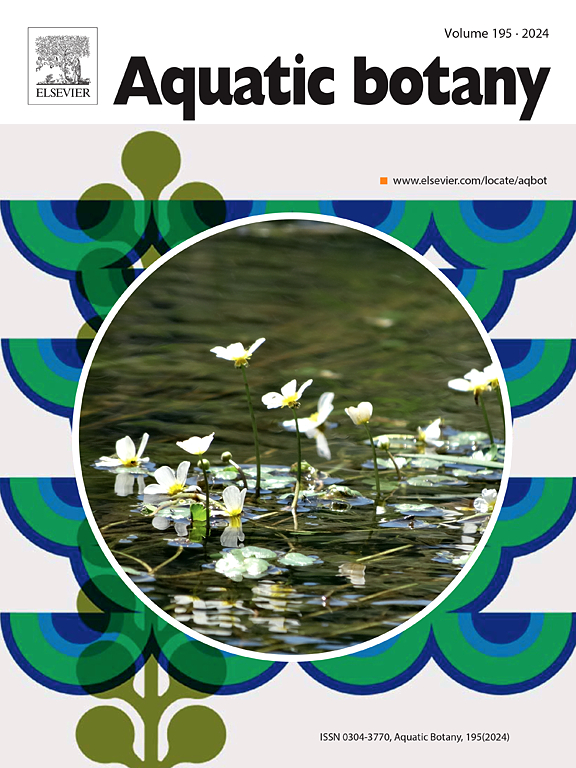Non-destructive biomass estimation for eelgrass (Zostera marina): Allometric and percent cover-biomass relationships vary with environmental conditions
IF 2.6
4区 生物学
Q2 MARINE & FRESHWATER BIOLOGY
引用次数: 0
Abstract
Estimating plant biomass reliably over large areas while minimizing impacts on sampled habitats is an important goal in plant ecology. Often, this is accomplished by first using a small number of harvested plants to quantify the relationship between plant biomass and less destructive predictor variables (e.g., height, cover), and then applying this relationship across larger spatial scales. However, the influence of environmental conditions on these relationships is often poorly understood. Here, we assess the impact of environmental variability on two biomass estimation functions for the seagrass Zostera marina in Atlantic Canada: the allometric leaf length-weight relationship and the relationship between percent cover and above-ground biomass (AGBM). First, we determined allometric and cover-AGBM regression relationships at the regional level using data from all sites pooled. We then investigated whether these models could be improved by including a site group covariate based on principal component analysis of site-level environmental data. At the regional level, allometric and cover-biomass models were both strongly significant, although uncertainty was high in the cover-AGBM model. Both models improved markedly when environmental variability (i.e., site group) was included: in warm, shallow conditions, eelgrass leaves were lighter for a given length, and AGBM increased at a slower curvilinear rate with percent cover. This indicates that environmental effects on eelgrass morphological traits not typically included in biomass models (e.g., leaf thickness, rigidity) can be important. Our study suggests that environmental effects on eelgrass biomass models should be considered, particularly when highly accurate estimates with low uncertainty are required.
大叶藻(Zostera marina)的非破坏性生物量估算:异速生长和覆盖度百分比-生物量关系随环境条件的变化而变化
可靠地估算大面积的植物生物量,同时尽量减少对采样生境的影响是植物生态学的重要目标。通常,这是通过首先使用少量收获的植物来量化植物生物量与破坏性较小的预测变量(如高度、覆盖度)之间的关系,然后在更大的空间尺度上应用这种关系来实现的。然而,环境条件对这些关系的影响往往知之甚少。在此,我们评估了环境变率对加拿大大西洋海草的两个生物量估算函数的影响:异速生长叶长-重关系和盖度百分比与地上生物量(AGBM)的关系。首先,我们利用汇集的所有站点的数据确定了区域水平上异速生长和覆盖- agbm的回归关系。然后,我们研究了这些模型是否可以通过包含基于站点级环境数据主成分分析的站点组协变量来改进。在区域水平上,异速生长模式和盖度-生物量模式均具有显著性,但盖度- agbm模式的不确定性较高。当包括环境变异性(即站点组)时,这两个模型都显着改善:在温暖,浅的条件下,给定长度的大叶藻叶子较轻,AGBM以较慢的曲线速率增加。这表明环境对大叶藻形态特征的影响通常不包括在生物量模型中(例如,叶片厚度,硬度)可能是重要的。我们的研究表明,环境对大叶藻生物量模型的影响应该被考虑在内,特别是当需要高度准确和低不确定性的估计时。
本文章由计算机程序翻译,如有差异,请以英文原文为准。
求助全文
约1分钟内获得全文
求助全文
来源期刊

Aquatic Botany
生物-海洋与淡水生物学
CiteScore
3.80
自引率
5.60%
发文量
70
审稿时长
6 months
期刊介绍:
Aquatic Botany offers a platform for papers relevant to a broad international readership on fundamental and applied aspects of marine and freshwater macroscopic plants in a context of ecology or environmental biology. This includes molecular, biochemical and physiological aspects of macroscopic aquatic plants as well as the classification, structure, function, dynamics and ecological interactions in plant-dominated aquatic communities and ecosystems. It is an outlet for papers dealing with research on the consequences of disturbance and stressors (e.g. environmental fluctuations and climate change, pollution, grazing and pathogens), use and management of aquatic plants (plant production and decomposition, commercial harvest, plant control) and the conservation of aquatic plant communities (breeding, transplantation and restoration). Specialized publications on certain rare taxa or papers on aquatic macroscopic plants from under-represented regions in the world can also find their place, subject to editor evaluation. Studies on fungi or microalgae will remain outside the scope of Aquatic Botany.
 求助内容:
求助内容: 应助结果提醒方式:
应助结果提醒方式:


